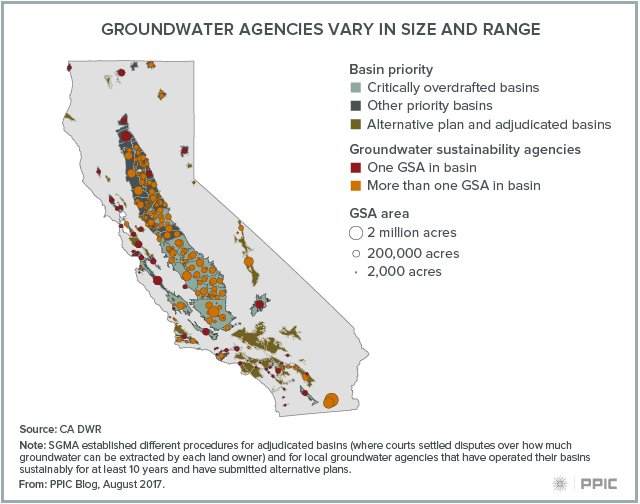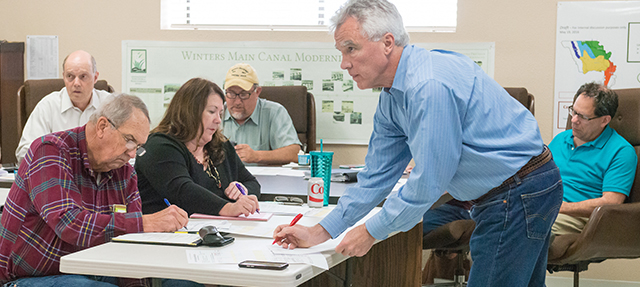California’s water management is a complex stew with many cooks. At the local level, hundreds of irrigation districts and urban water agencies and a few thousand small drinking water suppliers are responsible for a wide variety of water-related issues. And it just got more complex: as of June 30, more than 250 newly formed Groundwater Sustainability Agencies (GSAs) were added to the mix.
The 2014 Sustainable Groundwater Management Act (SGMA) directed local agencies to develop institutions, plans, and implementation strategies to sustainably manage their groundwater resources for the long run. As a result, more than 250 local agencies have formed GSAs in 140 “priority basins” (those that account for most of California’s groundwater use). More than 70 percent of the new GSAs are in the San Joaquin Valley and the Sacramento Valley—regions whose large groundwater basins supply farms, cities, and small rural communities.
A variety of parties can form GSAs, though most are made up of local agencies such as counties, cities, and irrigation districts. A GSA can also be formed by a single entity, such an irrigation district—Westlands Water District has formed one. It can be formed by groups of agencies, as is the case with the Merced Subbasin GSA, which includes six public agencies with water management or land use authority. These parties vary widely in their interests and experience in groundwater management.
The first task of the GSAs will be to develop groundwater sustainability plans for their basins. In basins with multiple GSAs, the agencies will either have to create a common plan or have an agreement to coordinate plans. This is no small task, given the number of agencies and their institutional diversity. Anticipating some of these complexities, the Department of Water Resources has already published a set of documents to guide plan development.
Although GSAs and their local partners will have the lead responsibility for developing and implementing groundwater sustainability plans, the state can play a pivotal supportive role. Given the varying technical and institutional capacity at the local scale and the challenges of coordinating different plans, a number of tools could help GSAs implement effective programs in ways that reduce conflict and foster success.
Developing common accounting standards is a top priority. GSAs must speak the same language to ensure consistency in groundwater budgets across agencies and basins. Statewide standards are needed on matters such as units used and frequency of measurement to enable comparability, auditability, and consistent analysis and management. Accounting templates and modeling standards could help guide this process. The Department of Water Resources has developed online reporting standards for other water sectors—such as the templates for submitting Urban Water Management Plans that standardize basic information agencies must submit—which might be a good model to follow. This might also help bridge some chronic water data gaps that have made it more difficult to manage California’s water.
The state could also provide technical guidance on developing local monitoring and enforcement regulations, which will be key to implementing the plans. Critically overdrafted basins—where long-term pumping has exceeded the rate of replenishment—will need to develop strategies to increase recharge and reduce pumping. Doing this well will require measuring groundwater extraction, setting overall pumping limits, and establishing pumping allocations. These tasks will help to establish a water budget, and are also essential to implementing innovative mechanisms such as incentives for recharge, storing groundwater for later use, and trading, which can add flexibility in groundwater management. Making these tools available for every agency, no matter its size and capabilities, will help ease the transition to sustainable management with minimal economic disruptions.
Getting to groundwater sustainability might be the most challenging issue in California’s water management for the foreseeable future. But it also provides opportunities to overcome some chronic water management gaps and encourage stakeholders to work cooperatively in a basin-scale approach. Local leadership is key to defining the proper solutions for each basin. But state guidance will also be essential to coordinate efforts and to promote innovation and knowledge sharing across the intricate landscape of agencies.

Read the report Accounting for California’s Water (July 2016)
Read the report Water Stress and a Changing San Joaquin Valley (March 2017)
Read “Groundwater in California” (PPIC fact sheet, May 2017)
Visit the PPIC Water Policy Center



